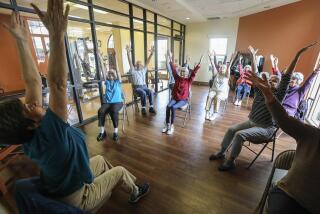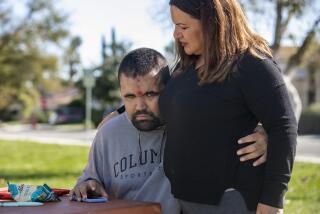Alzheimer’s Caregivers Work at Own Risk
LAGUNA HILLS — Nurse’s aide Francine Herrle rushed to the room of an Alzheimer’s patient just in time to prevent the 89-year-old woman from falling.
The patient, Helen Marshall, was slipping while another aide was moving her from a wheelchair to her bed. As Herrle wrapped her arms around the woman, Marshall smacked Herrle in the jaw several times and socked the other aide in the stomach.
The blows broke Herrle’s jaw and damaged both jaw joints beyond repair. Herrle sued the estate of Marshall, who had died shortly after that 1988 incident in the Palm Terrace convalescent home in Laguna Hills.
But Herrle’s hopes of a $200,000 award were dashed by the state Court of Appeal, which ruled that Herrle couldn’t seek damages because she assumed the risk of being injured by a patient when she took the job.
The state Supreme Court this month refused to hear an appeal, which means that trial courts statewide must follow the appellate decision.
The three-judge panel, over a strong dissent, found that Alzheimer’s patients, in essence, are mentally incompetent and aren’t liable for their actions inside care facilities. Health-care workers, on the other hand, are able to protect themselves and assume the risk of any harm, the court found.
The decision, turning its back on an old California case, means that the private health-care industry for the first time comes under a state doctrine barring employees in certain fields from suing others who cause them injuries at work. Injured firefighters, for instance, can’t sue a person who starts a fire. Veterinarians who are bitten while treating a dog can’t sue the owner.
“This case has incredibly significant social implications partly because of the huge rise in Alzheimer’s victims,” said Marjorie G. Fuller, a Fullerton lawyer who represents the Alzheimer’s Assn. of Orange County.
“It’s not that we suddenly discovered Alzheimer’s, it’s that people are living longer and getting all sorts of old-age diseases,” she said. “What do you do with them? Who’s going to care for them?”
*
Alzheimer’s alone afflicts more than 4 million Americans, including 500,000 in California, and their families already pay most of the annual $100-billion cost of treatment and care. Such diseases aren’t usually covered by insurance.
More and more, experts say, the task of caring for the ailing elderly, especially those with mind-rending diseases, is being turned over to health-care workers.
The California Psychiatric Assn., which supported Herrle’s appeal, warns that health-care workers now may start using more restrictive and less humane measures--such as restraints or sedatives--in treating potentially combative patients.
“The goal of treatment for those who are mentally impaired is to use the least restrictive method,” said the group’s lawyer, Daniel H. Willick of Los Angeles. “So this decision is a big step backward.”
Home health-care workers face even greater risks, from belligerent family members to dogs protecting their ill masters, said James E. Murray, deputy counsel for the National Assn. for Home Care in Washington.
“I had a home health-care agency call up and say they can’t do a particular medical procedure anymore because it’s painful and the patient keeps loading and unloading his gun during it,” he said.
But for the Alzheimer’s Assn. and the American Assn. of Retired Persons, which supported Marshall, the ruling is a victory for patients who already are forced to spend their life savings for their care and treatment.
Fuller, who represents the Alzheimer’s organization and is married to a physician, scoffs at the idea that those in the healing profession will become less caring. “People who go into it do it because they want to heal, to help others. I’ve never met a person who stopped and said he won’t help because he might get hurt and won’t be able to sue.”
*
Courts in Florida and Wisconsin have sided with patients in similar cases, but the Herrle ruling is the first in California to focus on whether Alzheimer’s patients are responsible for their actions, Fuller noted.
Under California law, those who are mentally incompetent generally are still liable for the injuries they cause, even though in job settings, workers’ compensation insurance covers basic medical costs as it did in Herrle’s case.
In 1959, the state Supreme Court allowed a nurse to recover damages from a delirious alcoholic patient who beat her severely while she was treating him in a sanitarium.
Even in the Herrle case, the appellate court agreed that Alzheimer’s victims who drive cars in public and cause injuries are liable for their actions. But the panel reasoned that Alzheimer’s victims should be protected when they are housed in health-care facilities, where they are sent for the very reason that they can’t be controlled at home.
Health-care workers--even at general facilities like convalescent homes--should be trained properly to handle combative patients, said Kim Robinson, program director for the Alzheimer’s Assn. of Orange County.
If workers--as well as family members providing care at home--were properly trained, restraints and other drastic measures wouldn’t be needed, she said.
“Violence is a symptom that some Alzheimer’s patients have,” she said. “It’s very difficult to find places for those who have that symptom. A lot of our patients have gone from facility to facility, and sometimes they end up in psychiatric units. That just underscores the need for training.”
Herrle said she was trained to handle difficult patients, though she hadn’t finished all of her nurse’s aide training. She said she did the best she could under the circumstances.
Richard A. Jones, a Santa Ana lawyer for Marshall’s estate, acknowledged that the issues presented a “tough case.” But he pointed out that Herrle chose her profession.
“We make decisions in the employment we take,” he said. “Nurses go to work in the AIDS ward for children. There’s a lot of risk in that. They need to be commended. But if a nurse pricks herself with a needle, she shouldn’t be allowed to sue the parents of that baby.”
While that may be true, says Herrle’s attorney, Joseph Powell of San Juan Capistrano, it doesn’t mean that a nurse’s aide has to worry about all possible injuries from patients or others at work.
“Working as a certified nurse’s aide in a convalescent home should not be deemed a ‘hazardous’ occupation,” he argued in court papers.
*
Helen Marshall was a short, stocky woman who was cheerful, friendly and active. She planned she and her husband’s 60th wedding anniversary bash at the Leisure World community clubhouse in Laguna Hills in 1986.
“She was alert right up until then,” said Russ Marshall, the couple’s only son. But symptoms of Alzheimer’s soon took over. She eventually failed to recognize her husband at times.
“He would be sitting there talking to her, and she’d go out of the room and come back and swear he was a different person,” Marshall said. “She would get up in the middle of night and cook; but she forgot how to cook and would just throw a frozen meal on the stove, wrapper and all.”
She got progressively worse, as Alzheimer’s patients do, and lost weight quickly. Her family couldn’t control her and placed her in a nursing home in June 1988. Almost immediately, she was confined to a wheelchair or bed, Marshall said.
“People would try to help and she’d get upset,” he said. “Most of time, it was pretty benign. But once in awhile, they’d try to touch her, and she’d get angry.”
She would push people away, he said, but he never saw her hit anyone and never heard from health-care workers that she had hit anyone. But she was becoming more belligerent when it came time for workers to change her clothes or move her.
The family placed her in September 1988 at Palm Terrace, where a young Francine Herrle had taken her first nursing home job only a month earlier.
Herrle, then 22, had been eager to enter the health-care profession. She was lean, healthy and tall--5-foot-10. Colleagues often asked her for help with their patients.
After dinner one day in mid-September, Herrle said, she was walking near Marshall’s room when an aide called for assistance. Herrle said she had been taught to get behind patients when moving them, but the wheelchair and other obstacles were in the way. As Herrle approached the patient from the front to help lift her, Marshall began swinging.
“She just went wham, bam, zoom,” the other aide, Debora L. Brechtel, told lawyers.
After Herrle got Marshall in bed, she bent over to lift a guard rail and Marshall slugged her once more. The startled nurse’s aide, her face turning red and beginning to swell, spent the rest of her shift swallowing aspirin and holding ice bags to her cheeks.
With the first of three surgeries looming, Herrle was persuaded by family members and Palm Terrace colleagues to see a lawyer. Nearly a year after the incident, Powell filed the lawsuit, seeking damages up to the limits of Marshall’s homeowner’s insurance.
*
State law is clear that mental incompetents must pay for the injuries they cause: “A person of unsound mind, of whatever degree, is civilly liable for a wrong done by the person . . . .”
An arbitrator awarded Herrle $200,000, but a Superior Court judge threw out the award.
For the Court of Appeal, the issue boiled down to whether Herrle, a minimum-wage worker, assumed the risk of being injured by an elderly, feisty Alzheimer’s patient. The court, in a majority opinion written by Justice William F. Rylaarsdam, decided that Herrle assumed the risk of being injured by an elderly, feisty Alzheimer’s patient.
“Marshall was placed specifically in the hospital’s care in part to protect her from injuring herself and others because of her violent tendencies,” the judge wrote. “This is not a case of a person suffering from senile dementia who gets in a car and causes an accident.”
Justice Edward J. Wallin dissented, calling the majority’s ruling “both bad law and bad policy.” He argued that Alzheimer’s patients who are mentally incompetent shouldn’t be insulated from liability.
“Herrle was hired as a nurse’s aide in a private convalescent hospital and was charged with caring for elderly patients in general,” Wallin wrote. “She was not hired for the sole purpose of preventing potentially violent Alzheimer’s patients from injuring themselves and others.”
“The only option for caregivers such as Herrle,” he said, “is to change professions or provide less compassionate care. Our most vulnerable elderly citizens deserve legal rules that encourage the best possible care; so do their caregivers.”
Regardless of legal ramifications, many health-care professionals believe that, for practical purposes, they must assume all risks and must be prepared for anything.
“All hospitals are required to make sure employees have training to protect themselves, whether from someone outside coming in brandishing a gun or from combative patients,” said Patricia A. Wardell, executive director of quality management at St. Jude Medical Center in Fullerton.
But, she acknowledged, she’s never handled a situation in which an employee was injured by a patient “seriously enough for this to be an issue.”
For Herrle, who now lives in Brea, workers’ compensation has paid for basic medical coverage, as well as two-thirds of the $6.75-an-hour wage for work days missed because of operations and recoveries.
But it hardly pays for the daily ritual of agony: the locked jaw in the morning, the grinding bones, the difficulty eating, the inability to sing, the tired jaw by the end of the day.
“I’m constantly aware of it,” Herrle said.
(BEGIN TEXT OF INFOBOX / INFOGRAPHIC)
Facts About Alzheimer’s Disease
* More than 4 million people in the U.S. have Alzheimer’s disease, 500,000 in California and 40,000 in Orange County.
* By the middle of the next century, the number of cases is expected to reach 14 million nationwide.
* The average cost of Alzheimer’s care in a nursing home is $42,000 yearly.
* Alzheimer’s is the third most expensive disease in the U.S., after heart disease and cancer, costing more than $100 billion per year.
* One person in 10 older than 65 and nearly half of those past 85 have Alzheimer’s.
* Alzheimer’s patients may live for three to 30 years after symptoms appear, for much of that time needing full-time care.
* Average lifetime cost of Alzheimer’s disease per person: $174,000.
Alzheimer’s Symptoms
Memory loss is only one symptom of Alzheimer’s. As the disease progresses, patients may become:
* Irritable
* Physically combative
* Suspicious
* Fearful and anxious
* Agitated
Orange County Impact
An average of 54 new cases of Alzheimer’s disease are diagnosed each year in Orange County. The trend for the last five years:
1991: 78 new cases
1992: 49
1993: 33
1994: 46
1995: 66
Caregiver Training
The Alzheimer’s Assn. of Orange County’s TEAM program provides training workshops for nursing home employees and others caring for Alzheimer’s patients. The eight-hour program covers:
* Medical issues
* Behavioral problems
* Communication techniques
* Ethical dilemmas
* Stress management
* Hands-on care
Facilities sponsoring TEAM training receive:
* On-site visit to assess needs
* Certificate of completion for employees and facility
* On-site training sessions
* Follow-up evaluation and support
* Inclusion in Alzheimer’s Assn. referral lists
Information: (714) 283-1111
Source: Alzheimer’s Assn. of Orange County, Orange County Health Care Agency; Researched by JANICE L. JONES/Los Angeles Times
More to Read
Sign up for Essential California
The most important California stories and recommendations in your inbox every morning.
You may occasionally receive promotional content from the Los Angeles Times.










